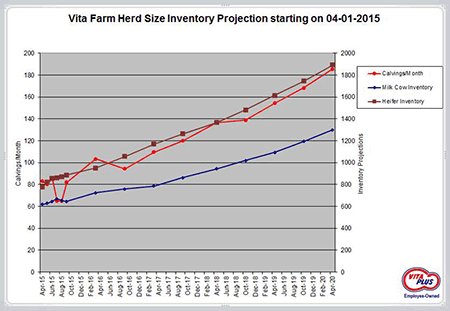
Regional Calf Report: Ohio – Dr. Andy Kniesly, Vita Plus
 By Dr. Andy Kniesly, Vita Plus dairy consutlant
By Dr. Andy Kniesly, Vita Plus dairy consutlantHere in Northeast Ohio, as milk prices have fallen, we are reviewing all areas of the farm to find opportunities to optimize production strategies.
One area that is often reviewed is the replacement heifers. Heifers are the future of our herds, so we want to raise them right. But they are also an expense until they freshen for the first time, so we want to raise them efficiently.
As we think about our replacements, it is important to ask, “How many replacements do I need?”
The answer to this question is very farm-specific and depends on many factors like age at first calving, reproductive efficiency, future expansion plans, cull rate, etc. To help answer the question, we can use tools like a Herd Size Inventory Projection calculator (shown in image below).
 Another factor that may influence the number of replacements is the physical space available. Overstocking heifers can drastically reduce efficiency through an increased incidence of health problems, reduced average daily gains, increased variability in size and performance, increased reproductive issues, and/or variability in age at first calving.
Another factor that may influence the number of replacements is the physical space available. Overstocking heifers can drastically reduce efficiency through an increased incidence of health problems, reduced average daily gains, increased variability in size and performance, increased reproductive issues, and/or variability in age at first calving.
Just because we need more replacements for the future doesn’t mean we should always raise all of our own replacements. Custom heifer growers or the sale of some heifers may allow us to be more efficient with the heifers we do keep.
If we make a decision that we can or need to sell some heifers, a newer tool that can help aid in our decision on which heifers to sell is genomic testing. Genomics do not guarantee the performance of an animal, but give us a better idea of which animals are likely to perform better. We must still make the decision to sell animals on an individual basis by considering other factors that might affect future performance, such as previous health problems, growth rate, and etc.
The next thing to consider is when to sell them. This is dependent on many variables, including overcrowding at different stages of growth, feed availability, feed costs, labor availability, labor costs, marketability of heifers at different ages, etc.
Genomic testing is not free, but it is a tool that may allow us to keep our better genetics, be more efficient with our replacements, minimize feed and labor costs, and/or generate income from the sale of animals. Each farm’s needs are different and, therefore, the options for your heifer replacements must be evaluated individually.
| Category: |
Business and economics Starting Strong - Calf Care Technology and data management |

